2016 Kawasaki Ninja ZX-10R First First-Ride Review + Video
Our Australian correspondent, Jeff Ware, was blessed with the jackpot of motojournalist opportunities: testing an important new superbike-class contender ahead of its official world launch event. Ware, author of our recent 1980s Turbo Bike Shootout and the test of a Cagiva 500cc Grand Prix racer, is one of just five journalists to have spun laps of Oz’s Wakefield Park circuit on Kawasaki’s latest ZX-10R, the most exciting new regular-production sportbike of 2016. Ware says he expected improvements, but what he experienced was stunning. —Kevin Duke
I’ve just sat down after a day cutting about 40 laps on the new ZX-10R at a world-exclusive first test, and I’m still trying to come to terms with just how good the bike is and why. In short, Kawasaki said to itself, “Bugger all the cosmetic and marketing-related fashion crap, let’s just make this beast lap faster and easier than anything else anyone can buy. If a part doesn’t improve lap times, it’s straight in the bin.”
Project leader Yoshimoto Matsuda sums it up after his technical chat, “When you climb a mountain, you don’t carry a big bag of nice clothes and fine food. You won’t get to the top carrying that rubbish.”
The enthusiasm on Matsuda-san’s face says it all as he explains how hard the Team Green engineers and test riders have worked and, most importantly, how much they have used the invaluable feedback from World Superbike riders Tom Sykes and Jonathan Rea, both Kawasaki #1 plate holders.
Riding Jonathan Rea’s Kawasaki ZX-10R Superbike
Kawasaki has tapped into the feelings of race fans like me. The KRT livery on my test bike looks hot and makes me feel even more like Tom Sykes than my beard, specially grown for today, does. The tail unit looks sharper and that ugly muffler is gone, replaced with a neat titanium unit. The reshaped upper cowl looks like the SBK fairing, and the dash is at least bigger than an iPhone, unlike another liter-class bike’s tiny clocks. It looks fast and has no crap hanging off it.
So what was it like to ride? In a word, rewarding.
As I familiarize myself on the bike, the ergonomics feel fantastic but I would prefer the ’pegs around 5mm lower. Aside from that I feel comfy and familiar as I warm up. The new ’bar position puts me over the front a little more, and I feel confident in the front end. Down the chute, tucked in, the larger frontal area completely isolates me from the airflow even though I am over six-feet tall and 200 pounds. Aside from these things, the bike feels like the previous one. But what about the performance?
As I approach the fast right kink at the end of the short straight, I brake hard for the first time, trying to feel for the limit of the SC1 front tire. The feel and feedback from the forks and Brembo package is the most refined I have felt on any production bike and only matched by the factory superbikes I have tested. This braking area is a kink that is off camber and of tightening radius, and the 10R eats it up. Stunning.
I sometimes struggled on the previous 10R when braking hard while turning in and shifting down gears. I felt the bike needed to be wrestled onto its side and continue to require continual pressure to keep it leaned over before firing off the turn.
On the new bike my arms are relaxed, I’m stopping the bike 20% harder, it is heading to the apex where I am looking, basically on its own, completely stable thanks to the brake assist and closer gear ratios making rpm changes less on downshifts. The 10R is tracking through the turn with no stand-up, and the next instant I’m exiting on full 100% throttle, driving hard up a long right-hand uphill turn. The 10R wheelspins ever so slightly and the front wheel hovers an inch off the ground as the electronics keep me out of the hospital. It is stunning to experience and easy to trust.
Repeating this process corner after corner means I end up lapping only a few seconds off my normal time here on a slick-shod 1000cc production based superbike. I’m impressed and I feel like I can keep going all day, not even raising a sweat. This has to be the easiest superbike-class machine to ride fast that I’ve ever experienced.
As I head downhill and into the fast left dogleg a few more laps in, I push that little bit harder and find myself running really deep. I repeat this a few times. No problem. For the next session I adjust the Engine Brake Assist and try that. Nope. I come in and switch it off and am immediately on line into that turn. This time I am better off with it off, but the options are there for various conditions. In the end I settle for full Power, S-KTRC 1 (Sport-Kawasaki Traction Control), KEBC off. I try S-KTRC on all 5 settings including off and prefer 1, the least intrusive, to keep the wheels inline. This test machine wasn’t equipped with ABS ().
Reeling off lap after lap, I focus on individual points that have been revised. The fork action is like nothing I have experienced. Silky smooth over high- and low-speed bumps, soft and subtle yet loads of support on hard braking, even sudden, sharp hard braking. The brake feel is so intimate and, although the same spec as the Ducati Panigale 1299, the ZX-10R package feels more intuitive when it comes to small lever modulations, particularly braking while on the side of the tire. ()
Out the back, the rear suspension again offers fantastic support and stability on hard acceleration and into turns. There is abundant feel from the rear tire, and the bike is not pitchy at all. However, I would prefer a more one-to-one connection between the throttle and the rear tire. Braking hard into turns, I feel I am sitting in the bike not on top of it, which I like, something I have struggled with on other new models, where I end up with arm pump. I find many new sportsbikes too tall in the seat and low in the ’bars. On the 10R, my arms feel like they’re not even getting used much at all.
The engine is the heart of any motorcycle (). If, like me, you like cutting fast laps, then you will appreciate this engine as it allows lots of early throttle roll. If you like a big stupid grin on your face after a triple-clamp pops up and smacks you on the chin when you open the throttle, you might find this engine boring. It allowed me to exit turns at 100% throttle in places I never have on a 1000cc sportbike. All of the torque and punch are delivered high in the rpm range, purposely, to allow easy fast drive. I felt like I was getting nowhere at times and it wasn’t until I noticed my lap times that I knew I was going fast.
I chatted to ex-WSBK legend and World Endurance Champ, Steve Martin, about this at the end of the day, and he agrees, saying, “That’s how a well-setup factory superbike feels with good electronics. You just feel you are getting nowhere but you are actually flying. We were going fast today but it just felt too smooth to be fast.”
The gearbox ratios are revised, but at this short track, I only just grab fourth gear, so I’ll reserve comment until I ride at a longer, faster track. The quickshifter needs a solid boot but is consistent and reliable, which is handy as I find I need to keep the engine spinning above 9000 rpm to get going.
From an engineering point of view, the revised engine character is a huge achievement. I’m treating it like a supersport 600 engine not a 1000, as the power comes in with such grace that there is no need to be too careful with the throttle. I switch the S-KTRC off to see if the rear Pirelli lights up everywhere with my ham-fisted throttle approach and it doesn’t at all. In fact, I have to double-check that the S-KTRC is OFF, such is the tractable character of the engine.
Top-end power is, as always on a 10R, absolutely stonking and is giving me a laugh in a few sections of the lap. But I may be fooled by the fact there are slower turns and the acceleration up top feels extra fast, so I decide to head in and I jump on a Ninja H2 for a few laps to compare these engines, having spent some time on the H2 on the road and deeming it mental. To my surprise, I’ve got the H2 wide open and wanting more on the straighter sections of track – proving to me that the 10R is damn fast but just does a good job masking it, as the H2 doesn’t seem to be much faster, just more explosive.
At the end of the day, I have to hand it to Kawasaki. This time they really have done it and produced the best ZX-10R yet. It’s the closest thing to the real superbike machines currently available. I can say with confidence that this is one very special machine.
2016 Kawasaki Ninja ZX-10R
+ Highs
- Amazing power delivery
- Stunning brakes
- Front-end confidence
– Sighs
- Super-tall first-gear ratio
- No auto-blip downshifter
- A little soft on initial throttle opening
Electronics
The launch control has three pre-set modes for wet or dry conditions. I tried all levels and found 1 the best.
The electronic systems on the 2016 Kawasaki ZX-10R have been heavily updated, including a new fully electronic throttle actuation system which has enabled the Kawasaki traction control system to further evolve, with launch control (KLCM) and engine brake control (KEBC) added.
The new Sport-Kawasaki Traction Control (S-KTRC) system includes five modes for greater control than ever before, particularly aimed at improving performance on the circuit, with modes one and two intended for race/circuit use. The system is a hybrid predictive/feedback-type system, which uses Kawasaki’s proprietary dynamic modelling software, and is further refined with the latest generation Bosch IMU (Inertial Measurement Unit) to provide five measured parameters and a sixth calculated by the ECU. Engine rpm, throttle position, slippage, acceleration and more are all also measured to allow the dynamic control, which allows unfavorable conditions to be predicted. Drive is controlled via the ignition and electronic throttle valves and sampled every 5 milliseconds.
The Kawasaki Launch Control Mode (KLCM) offers three levels of adjustment, with riders able to take off with full throttle, with the system limiting engine speed and regulating wheel spin and lift. It is disengaged at over 150km/h or from third gear onwards, as well as when engine temperature exceeds 100ºC, and also deactivates for 150 seconds after use to protect the clutch during consecutive uses.
The Kawasaki Engine Brake Control can be toggled with the bike at a stop and allows engine braking to be reduced from that normally offered by the back-torque limiting clutch, with the setting saved until changed, including when the bike is turned off.
The Kawasaki Intelligent anti-lock Brake System (KIBS) uses not only front and rear wheel sensors, but also communicates directly with the ECU – a feature first introduced on a mass-produced motorcycle on the ZX-10R in 2011 – taking into account throttle position, engine speed, clutch actuation and gear position to allow optimal control and minimize intrusiveness. Front caliper hydraulic pressure is also monitored, with the KIBS system regulating pressure with smaller increments than a traditional ABS system, for smoother operation with less noticeable pulses, better rear wheel lift control and a smaller reduction in braking performance during activation. The KIBS system further communicates with the Bosch IMU, allowing a new cornering management function on the ABS-equipped models, which helps rider’s track their line through a corner on the brakes, by minimizing the effect of braking on standing the bike up mid-corner.
Other standard features include the Kawasaki Quick Shifter (KQS), allowing seamless upshifts and, when combined with the optional race-kit ECU, is also capable of clutchless downshifting. An Ohlins Electronic Steering Damper communicates with the ECU to provide automatic optimal performance in any condition.
Three power modes are available as standard, with Full offering what the name suggests, while Middle reduces power to approximately 80%, and Low reducing power to approximately 60%.
An optional race kit accessory is also available that allows the KIBS to be switched to ‘R OFF’ which limits the system to front brakes only, or ‘OFF’ completely.
Chassis
The lighter crankshaft and a number of changes to the chassis deliver a much lighter-handling machine. The big improvement being corner entry and fast change of direction, or flickability.
With a lightened crankshaft one of the benefits is that overall cornering performance is improved. Ware says the 10R doesn’t stand up under braking or fight to stay on full lean.
The handling benefits of the lighter crankshaft come from the reduced gyroscopic effect of the rotating crank, meaning handling is lighter and turn-in quicker. The reduced weight also helps with the bike’s center of gravity, further aiding cornering performance.
The twin-spar aluminium frame traces a direct line from the steering head to the swingarm pivot, delivering linear behaviour. Frame twist was tuned to be as close to the main pipes as possible, which increases rider control.
The head pipe is moved 7.5mm closer to the rider to place more weight on the front, giving more front-end feel and increased stability and confidence on corner entry, also helping with direction changes and braking. The reverse offset collars in the race kit allow adjustment 4mm either way from standard, while other collars allow head angle changes. The swingarm pivot point can also be adjusted via the race kit parts.
The swingarm’s optimized torsional rigidity contributes to the bike’s nimbler handling and is 15.8mm longer, contributing to the increased front weight bias and increasing traction on corner exit.
A larger upper cowl improves the aero performance of the bike-rider package, increases wind protection and enables the rider to move more easily setting up for a corner. The screen is fully supported by the upper cowl now, and has wind inlets to stop negative cockpit pressure and helmet buffeting. The front fender is redesigned to direct more air to the radiator.
The 43mm Balance Free Forks bring SBK technology to the streets. Showa and Kawasaki developed the fork after Yoshimoto Matsuda approached Showa and convinced them to produce a race-spec mass-produced suspension system using their data from the Kawasaki SBK effort.
The Showa 43mm Balance Free Fork is the first mass-produced of their kind, bringing WSB technology to the public. Damping force is generated in the nitrogen-charged chamber outside of the main tube. This allows the piston to act as a pump, pushing oil towards the valves. Rebound and compression are completely independent circuits.
The high-spec fork offer numerous benefits such as increased ride comfort, increased braking stability, increased front-end feel, and independently adjustable compression and rebound circuits. Damping force is generated outside of the main tube in the damping force chamber, which allows the piston in the main tube to act as a pump, pushing oil towards the valves. This helps reduce pressure balance fluctuations, which can cause cavitation, as a result of compression and extension. The external compression chamber is pressurized with nitrogen gas, enabling very stable pressure increases. The compression and rebound circuits are completely independent from each other, giving smooth, optimal oil flows.
The M50 Brembo calipers are top spec, the same as on the Panigale 1299 S. Stainless braided lines and whopping 330mm semi-floating rotors ensure monster stopping power and feel up there with a factory racer. The cast alloy wheels are just 20.7 lbs. for the pair.
The Showa Balance Free Rear Cushion shock is a lighter and more compact version of the previous unit. Like the fork, the damping force is generated in an external chamber, and compression and rebound are independent circuits. The position of the shock also minimizes heat transfer from the engine or exhaust, giving more stable damping.
The brake system is all-new. Brembo M50 monoblock radial-mount calipers are used. They squeeze huge 330mm Brembo semi-floating rotors and a Brembo master-cylinder and reservoir. Each unit is tested and adjusted to eliminate any idle stroke in lever pull, to optimize initial braking. Stainless-steel lines complete the braking system.
Engine
All new in 2011, the ZX-10R engine was designed to promote early throttle opening and drive by moving torque higher in the rev range. The new engine retains this character but offers a stronger mid-range and is more responsive, spinning up quicker thanks to a lower moment of inertia, which benefits acceleration and deceleration (along with cornering performance). The developmental feedback came from the SBK team. The intake ports are machined in two stages, first at the valve seats, then at an inclined angle, to promote a straight path for the air. The polished ports allow a greater volume of fuel-air mixture, increasing power. The exhaust ports are also straighter and wider as well as polished, while the combustion chamber is reshaped and has larger 25.5mm exhaust valves up from 24.5mm. Intake valve diameter remains at 31mm. Both intake and exhaust valves are now Ti.
Revised camshaft profiles give greater overlap and more power at high rpm and are now made of chromoly to reduce weight. Larger coolant passages in the head were made possible by the use of long-reach spark plugs, increasing performance. The spark plugs have platinum tips, contributing to linear power delivery, particularly on initial throttle opening. They also have a very long service life. A half-nut cam-chain tensioner helps with more stable valve timing.
The combustion chamber is dome machined and shorter pistons (39.2mm – 37.7mm) are employed with revised crowns. Each piston is 5 grams lighter, contributing to quicker throttle response. The pistons are made from a new heat-resistant alloy and have dry-film lubricant coating on the skirts.
The crankshaft has a 20% lower moment of inertia, the most significant change brought about through SBK feedback. Acceleration, deceleration and cornering all benefit. Engine response is improved, while a single-shaft secondary balancer helps reduce engine vibration and also helps reduce the weight of the handlebar weights, aiding steering response marginally.
The big-end bearings are a new material reducing seizure risk, while the 2mm offset cylinders have 1mm thicker walls. The cylinders bores are machined with a dummy head bolted on, yielding high bore circularity and cylindricity. As a result, low-tension piston rings are used, decreasing drag. The offset bore (2mm toward the exhaust side relative to the crank center) reduces lateral piston force at the point of maximum combustion pressure, lowering piston loads and allowing the lighter pistons.
The cassette-style gearbox ratios are revised for track riding, with shorter ratios for second through sixth gears, aiding acceleration and more stable downshifting. A thinner clutch primary gear is 200g lighter. The exhaust header pipes are made from special heat-resistant titanium and have the same diameter and lengths as the race-use system. The muffler is also titanium.
The airbox is now at 10 liters, up 2 liters from previous, while the air cleaner is 1.6 times larger in area. Revised intake funnels match the new engine, with the shape changing from oval to round to match the throttle-bodies. The throttle-bodies are 47mm items and feature dual injectors per cylinder, the secondary for top-end rpm and the primary operating at all times. The ride-by-wire system allows full ECU control of the throttle valves, controlling fuel, air and engine braking.
2016 Kawasaki ZX-10R (ABS) | |
|---|---|
| MSRP | KRT Edition: $15,299; $16,299 with ABS Regular: $14,999; $15,999 with ABS |
| Colors | Lime Green KRT Edition, Metallic Matte Carbon Gray, |
| Max Power (Claimed) | 147.1kW (200 hp) at 13,000 rpm |
| Max Torque (Claimed) | 113.5Nm (83.8 lb-ft) at 11,500 rpm |
| Engine Type | Liquid-cooled, in-line four-cylinder, four-stroke, 16-valve, DOHC, four dual injection 47mm injectors |
| Electronics | S-KTRC, Ride Modes, KEBC, KLCM, KQS |
| Fueling | Four dual injection 47mm injectors, electronic throttle valve |
| Bore x Stroke | 76.0 x 55.0mm |
| Displacement | 998cc |
| Compression Ratio | 13.0:1 compression |
| Transmission | Six speed, cassette style |
| Clutch | Wet, multi-disc back-torque limiting clutch |
| Chassis | Cast aluminium twin-spar frame, aluminum swingarm |
| Rake | 25.0° |
| Trail | 107mm |
| Front Suspension | 43mm Showa BFF fork, external compression chamber, compression, rebound, preload adjustable |
| Rear Suspension | Showa BFRC lite shock, compression, rebound, preload adjustable, horizontal back-link |
| Front Brakes | (KIBS) Dual 330mm semi-floating Brembo rotors, Brembo radial Monoblock four-piston M50 calipers, Brembo master-cylinder |
| Rear Brakes | 220mm rotor, Nissin single-bore pin-slide caliper |
| Wheels & Tires | Three-spoke cast aluminium, 120/70-17 58W, 190/55–17 75W |
| Wheelbase | 1440mm (56.7 inches) |
| Seat Height | 835mm (32.9 inches) |
| Overall Length | 2090mm (82.3 inches) |
| Overall Width | 740mm (29.1 inches) |
| Wet Weight (Claimed | 454 lbs |
| Fuel Capacity | 17 liters (4.5 gallons) |
More by Jeff Ware



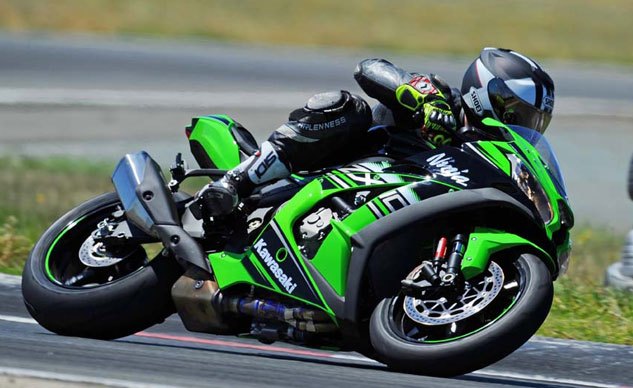
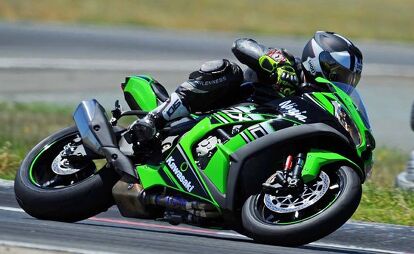































































































































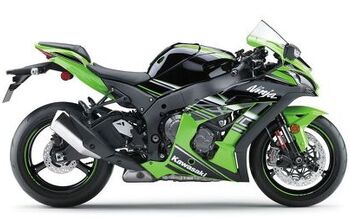
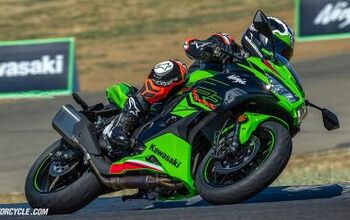
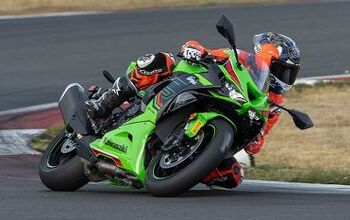
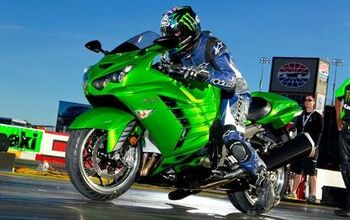











Comments
Join the conversation
Great! Now that the H2/H2R and ZX-10r are done and out of the way, can the engineers at Kawasaki please take their great skills, their egineering advances, and their technology and build the equivalent of Honda's Africa Twin, but 100lbs lighter? Full fairing, upright ergonomics, street tires please. 85 hp, 85 ft*lbs of torque should suffice. Extra long service intervals, bullet proof reliability, awesome handling. No electronics. Thank you!
I can't believe this is for sale to the public with warranty.